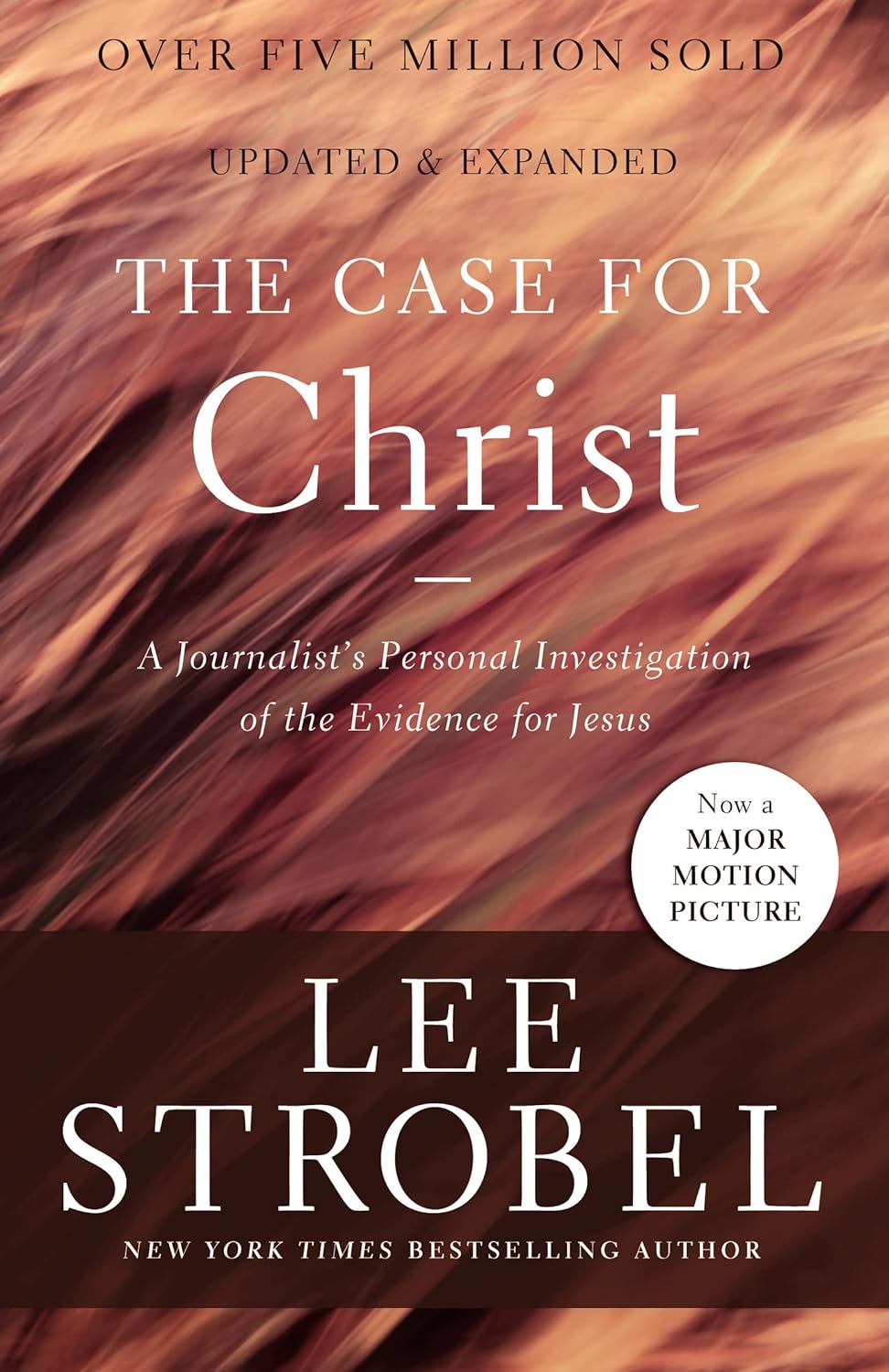The Case For Christ By Lee Strobel Book Review
If you click a link in this blog post and make a purchase I may receive a sponsored commission at no extra cost to you and this will help us to continue sharing this ministry.
Have you ever had one of those moments where you just had to find out the truth for yourself? The kind of curiosity that won’t let you rest until you’ve followed every lead and turned over every stone? That’s exactly the place Lee Strobel found himself in when he began his journey that would eventually become The Case for Christ.
This isn’t just another Christian book filled with theological arguments. It’s the story of one man’s honest search for truth a journey that begins in skepticism and ends in surrender. Lee Strobel didn’t set out to become a believer; he set out to disprove Christianity. But somewhere along the way, as he followed the facts, the facts began to follow him straight to the feet of Jesus.
Let’s explore this remarkable story not just what’s inside the pages of The Case for Christ, but how it challenges, uplifts, and transforms those who read it.

CLICK HERE TO BUY BOOK ON AMAZON
A Skeptic’s Quest For Truth
Before he was a best-selling author and speaker, Lee Strobel was an investigative journalist at The Chicago Tribune. Trained in law and evidence-based reporting, Strobel was known for his ability to find inconsistencies and dig out the truth. He wasn’t the kind of man who took things at face value and he certainly didn’t believe in God.
That’s what made it so shocking when his wife, Leslie, became a Christian. Her newfound faith seemed foreign and even a little unsettling to him. Strobel admitted he thought religion was “a crutch for weak-minded people.” But instead of walking away from his wife’s faith, he decided to challenge it the way any good journalist would.
He launched a two-year investigation into the evidence for Christianity. He wanted to find proof that Jesus was a myth, that the Bible was unreliable, and that faith was just wishful thinking. What he found instead was something far more compelling than he ever imagined.
The Structure of an Investigation
Strobel approaches The Case for Christ like a detective would approach a complex case. Each chapter is presented as an interview with experts in various fields: historians, theologians, medical professionals, and archaeologists. These aren’t random opinions they are carefully selected voices with strong credentials, from both religious and academic backgrounds.
Each expert faces Strobel’s sharp, skeptical questions head-on. For example:
-
Can we trust the New Testament as a historical document?
-
How do we know the Gospels weren’t changed or exaggerated?
-
Did Jesus really claim to be the Son of God?
-
Is there scientific or historical evidence that supports the resurrection?
Through these interviews, Strobel takes readers step-by-step through the same logical process he went through. It feels less like reading a theology book and more like watching a courtroom drama where the evidence is laid out piece by piece, and the reader gets to decide the verdict.
Evidence of Jesus’ Existence
One of the first things Strobel investigates is the very existence of Jesus. Was He a real historical figure, or just a legend built up over time?
The evidence he uncovers is surprisingly clear. Through interviews with scholars like Dr. Edwin Yamauchi, Strobel discovers that Jesus’ existence is confirmed by both Christian and non-Christian sources. Ancient historians such as Josephus and Tacitus mention Jesus explicitly, and archaeological discoveries consistently support the context of the Gospels.
For Strobel and for readers this section sets the tone for the rest of the book. The idea that Jesus was merely a myth doesn’t hold up under historical scrutiny. The foundation of the Christian story, it seems, is grounded in fact, not fantasy.
The Reliability of the Gospels
But what about the Bible itself? Strobel turns his attention to whether we can actually trust the New Testament accounts of Jesus’ life, death, and resurrection. After all, the Bible was written centuries ago so how do we know it hasn’t been distorted over time?
Through conversations with New Testament scholar Dr. Craig Blomberg, Strobel learns that the Gospels were written within a remarkably short time after the events they describe only a few decades, not centuries later as skeptics often claim.
Even more compelling, there are over 5,000 ancient Greek manuscripts of the New Testament an unparalleled number compared to other ancient works like Plato or Homer. This abundance of manuscripts makes it possible to cross-check for consistency, and remarkably, the differences are minor and do not affect the core message.
For Strobel this evidence begins to chip away at his skepticism. The more he examines the data, the more he realizes the Bible is one of the most historically reliable texts in existence.
Did Jesus Really Claim to Be God?
Next comes one of the most pivotal questions in the entire book who did Jesus say He was? Some argue that Jesus was just a wise moral teacher, not divine. But Strobel, never satisfied with surface answers, digs deeper.
Through experts like Dr. Ben Witherington III, Strobel discovers that Jesus didn’t leave much room for neutrality. His words and actions forgiving sins, accepting worship, declaring Himself one with the Father all point clearly to His divine identity.
Jesus didn’t just imply He was God; He directly claimed it. The reaction of those around Him religious leaders accusing Him of blasphemy makes this undeniable. Strobel realizes that Jesus forces a decision: either He was who He claimed to be, or He was delusional. There’s no middle ground.
The Crucifixion and Resurrection: The Heart of the Case
If the story ended at the cross, Christianity would just be another tragedy in human history. But the resurrection changes everything and it’s here that Strobel focuses most of his investigation.
He examines the crucifixion from a medical standpoint with Dr. Alexander Metherell, who provides chilling details about the physical toll of crucifixion. The description is graphic, but necessary it establishes beyond doubt that Jesus truly died on the cross. The “swoon theory” (the idea that Jesus merely fainted and later revived) doesn’t hold up against the medical evidence.
Then comes the resurrection itself. Strobel examines every theory: Did the disciples steal the body? Did they hallucinate the risen Christ? Were the stories simply made up? Each explanation collapses under its own weight. The disciples had nothing to gain by lying in fact, most of them were persecuted and killed for their testimony.
The empty tomb, the post-resurrection appearances, and the birth of the early church all point to one logical conclusion: something extraordinary happened. Strobel is faced with a truth that he can no longer deny the resurrection stands as one of the best-supported events in ancient history.
A Heart Transformed by Evidence
At this point in the book, the evidence has built up like a tidal wave. But the most powerful part of The Case for Christ isn’t found in the academic facts it’s in the personal transformation that follows.
Strobel describes how, after two years of research, he sat alone in his living room one night surrounded by his notes. Every piece of evidence pointed to the truth of Christianity. It wasn’t emotion that convinced him it was logic, history, and reason.
He wrote:
“It would take more faith to maintain my atheism than to believe in Jesus Christ.”
That night, Strobel gave his life to Christ. Not because he wanted to believe, but because he couldn’t deny the truth any longer.
His story is a reminder that faith and reason aren’t enemies. They work hand in hand. The same God who created our hearts for faith also created our minds for understanding.
Why This Book Resonates with So Many
There are countless Christian books that talk about faith, but what makes The Case for Christ unique is its accessibility. Strobel writes like a friend having an honest conversation, not a preacher lecturing from a pulpit. He doesn’t assume the reader already believes in fact, he invites skepticism.
This makes the book especially meaningful for:
-
People wrestling with doubt
-
Skeptics looking for rational answers
-
Believers who want to strengthen their faith
-
Families and friends of those who question Christianity
Strobel gives readers permission to ask questions even the hard ones. He reminds us that God isn’t threatened by our curiosity. True faith doesn’t fear investigation; it flourishes through it.
Key Themes and Lessons
As you journey through The Case for Christ, several powerful themes stand out lessons that apply to both our heads and hearts.
-
Faith is built on evidence.
Christianity isn’t wishful thinking; it’s a belief system rooted in historical truth. The resurrection isn’t just a story it’s a verifiable event that reshaped history. -
God invites our questions.
Strobel’s journey proves that doubt can be a doorway to deeper faith. When we seek the truth sincerely, God meets us there. -
Transformation comes through truth.
The facts alone didn’t change Strobel it was what those facts revealed: a Savior who loved him personally. -
Faith changes everything.
Strobel’s life didn’t just shift intellectually; it changed emotionally, relationally, and spiritually. His marriage healed, his priorities transformed, and his purpose became clear.
The Writing Style: Real, Raw, and Relatable
If you’re worried that this book might feel too “academic,” don’t be. Strobel’s writing feels like a mix between a personal memoir and a true-crime investigation. His journalist background shines through in the structure, pacing, and storytelling.
He pulls readers in with curiosity, keeps them hooked with evidence, and leaves them inspired by his personal transformation. Even the complex theological discussions are easy to follow because they’re framed as conversations not lectures.
The tone is humble, honest, and deeply human. Strobel doesn’t pretend to have all the answers; he simply invites readers to explore the evidence for themselves.
The Legacy of “The Case for Christ”
Since its release, The Case for Christ has sold millions of copies worldwide and has been adapted into a film. More importantly, it has helped countless people find faith not through emotional manipulation, but through genuine discovery.
Lee Strobel has since gone on to write several other books The Case for Faith, The Case for a Creator, The Case for Miracles all expanding on different aspects of Christian apologetics. But The Case for Christ remains his most personal and powerful work, because it’s where it all began.
The story of a man who set out to disprove God… and ended up finding Him.
Conclusion: A Case Worth Exploring
Reading The Case for Christ feels like sitting beside a friend who’s telling you about the greatest investigation of his life. It’s engaging, intelligent, and heartfelt but most of all, it’s real.
Strobel reminds us that faith isn’t the opposite of reason. It’s the fulfillment of it. The God of the Bible doesn’t ask us to believe blindly; He invites us to examine the evidence and discover that truth is, in fact, a Person Jesus Christ.
If you’ve ever struggled with questions about your faith or wondered whether Christianity can hold up to scrutiny, this book is the perfect place to start. And even if you’re already a believer, it will deepen your understanding and renew your appreciation for just how solid the foundation of your faith really is.
The Case for Christ isn’t just a book; it’s an invitation to seek, to question, and ultimately, to believe.
Because as Lee Strobel discovered when you truly look for the truth with an open heart you just might find that the case for Christ is stronger than you ever imagined.






